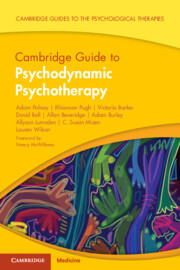Book contents
- Cambridge Guide to Psychodynamic Psychotherapy
- Cambridge Guides to the Psychological Therapies
- Reviews
- Cambridge Guide to Psychodynamic Psychotherapy
- Copyright page
- Dedication
- Contents
- Foreword
- Preface
- A Note from the Series Editor
- Acknowledgements
- Part 1: An Overview of the Model
- Part 2: The Model of Psychodynamic Psychotherapy into Practice
- Part 3: Application for Mental Health Presentations
- Applications of Psychodynamic Psychotherapy with Accompanying Case Study Description for Each Presentation
- Chapter 11 Psychodynamic Approaches to Anxiety
- Chapter 12 The Psychodynamics of Depressing/Depressed States
- Chapter 13 Dynamics of Borderline States of Mind
- Chapter 14 Narcissistic Difficulties, a Trans-Diagnostic Presentation Requiring a System-Wide Approach
- Part 4: Application of Psychodynamic Psychotherapy in Different Populations and in Different Settings
- Glossary of Terms
- Index
- References
Chapter 11 - Psychodynamic Approaches to Anxiety
from Applications of Psychodynamic Psychotherapy with Accompanying Case Study Description for Each Presentation
Published online by Cambridge University Press: 25 August 2023
- Cambridge Guide to Psychodynamic Psychotherapy
- Cambridge Guides to the Psychological Therapies
- Reviews
- Cambridge Guide to Psychodynamic Psychotherapy
- Copyright page
- Dedication
- Contents
- Foreword
- Preface
- A Note from the Series Editor
- Acknowledgements
- Part 1: An Overview of the Model
- Part 2: The Model of Psychodynamic Psychotherapy into Practice
- Part 3: Application for Mental Health Presentations
- Applications of Psychodynamic Psychotherapy with Accompanying Case Study Description for Each Presentation
- Chapter 11 Psychodynamic Approaches to Anxiety
- Chapter 12 The Psychodynamics of Depressing/Depressed States
- Chapter 13 Dynamics of Borderline States of Mind
- Chapter 14 Narcissistic Difficulties, a Trans-Diagnostic Presentation Requiring a System-Wide Approach
- Part 4: Application of Psychodynamic Psychotherapy in Different Populations and in Different Settings
- Glossary of Terms
- Index
- References
Summary
A psychodynamic approach to anxiety is not disorder specific; anxiety can and usually is present to varying degrees in all patients that are seen for psychodynamic psychotherapy. This chapter aims to shed some light on some psychodynamic approaches to thinking about anxieties. Using theory and clinical examples we think about how difficulties in containing processes between caregiver and infant early in the infant’s life may predispose to the persistence of archaic anxieties. We go on to explore the nature of separation and loss in relation to anxiety and finally, we reflect on how internal conflict and the role of a critical internal object can bring about anxiety. The clinical examples illustrate how wider variation in anxieties may present in therapy and the last section focuses on how the therapist may experience and respond to these different anxieties.
Keywords
- Type
- Chapter
- Information
- Cambridge Guide to Psychodynamic Psychotherapy , pp. 171 - 183Publisher: Cambridge University PressPrint publication year: 2023



